LX-5026 Quantifying the Indoor Light Environment
Technical Bulletins
Posted 2023
Last Updated 2023
LX-5026
Testing for Light Stability in Retail & Residential Environments
Abstract
Indoor products may be subjected to a wide range of interior lighting environments. These environments include residential incandescent, commercial fluorescent, and industrial metal halide illuminants. Products may also be exposed to sunlight coming through a window or an automobile windshield. Each of these light sources has its own unique spectrum. In a like manner, each material has its own unique spectral sensitivity. This paper surveys a wide variety of the most commonly used indoor light sources, including direct and indirect window-filtered sunlight. The results indicate that direct window-filtered sunlight is the most severe interior lighting condition that your product will probably see. Because a xenon arc test chamber can provide an excellent simulation of sunlight through window glass, it is the best method of simulating this worst-case indoor lighting environment for testing the light stability of your product.
Introduction
Light can be a significant cause of damage to inks, dyes, textiles, coatings, cosmetics, pharmaceuticals, papers, plastics, and other indoor materials. This damage may affect both a products aesthetic and physical properties. Aesthetic damage is usually in the form of fading, color change and gloss loss. Currently, a single standard (or benchmark) has not been established as the universal method for testing the light stability of interior products. This is because there are dozens of potential retail and residential lighting environments.
Spectrum
The electromagnetic spectrum is normally divided into ultraviolet light (UV), visible light, and infrared energy (IR). Infrared energy consists of wavelengths, which are longer than the visible red wavelengths and starts above about 760 nanometers (nm). Visible light is defined as the wavelengths between 400 and 760 nm. Ultraviolet light consists of radiation with a wavelength shorter than 400 nm.
To understand the significance of spectrum on photodegradation, we must look at the Quantum Theory, which states that, unlike other forms of energy, light comes in discrete particles called photons or quanta. Photons behave much like tiny projectiles traveling at the speed of light (they are even subject to gravity). The “size” of a photon is inversely proportional to wavelength - the shorter the wavelength, the bigger the photon. Photochemical reactions are caused by a single photon colliding with a single electron. If the photon is “big” enough (i.e., contains more energy than the organic bond strength) the electron is knocked out of its orbit and a reaction occurs. If the photon is not big enough, the energy imparted by the collision is harmlessly dissipated and no reaction occurs. For each type of chemical bond, there is a critical threshold size of photon (and hence a critical threshold wavelength) with enough energy to cause a reaction.
Light of any wavelength shorter than the threshold wavelength can break the bond, but light of wavelengths longer than the threshold can never break the bond - regardless of the intensity (brightness) of the light.
An analogy to the Quantum Theory is throwing objects at a window. If you threw 20 kilograms of sand at a window, one grain of sand at a time, the glass would remain intact. But if you threw one 5 kilogram rock, the glass would shatter.
Because of the Quantum effect, the shortest wavelengths of sunlight found on the earth's surface, the UV, are almost exclusively responsible for the photochemical damage done to modern exteriorgrade materials. Furthermore, even within the UV, the shorter wavelengths are vastly more destructive than the longer UV wavelengths. For interiorgrade materials like inks and dyes, longer wave UV and short wave visible often have a significant effect.
Once the bond is broken in the primary photochemical reaction, any number of degradation sequences can occur. The molecule may become weaker and its molecular weight may decrease. There may be a rearrangement of atoms within the molecule, resulting in a change in physical properties. There is frequently a chain reaction of damaging chemical changes.
IR radiation typically causes heat buildup in radiated specimens which can result in thermal degradation in some materials. IR does not cause photodegradation; however, the increased temperatures it creates will typically lead to an increase in the rate of photo-initiated degradation.
Spectral Sensitivity of Materials
The spectral sensitivity of a material is a measure of how the amount of damage, caused by a unit of light energy, varies according to the wavelength of light. Spectral sensitivity may vary greatly from material to material. Similar materials, formulated for the same application, may have significantly different spectral sensitivities. Figures 2 and 3 depict the spectral sensitivity of several common plastics. Notice how the sensitivity is usually inversely proportional to wavelength (i.e., shorter wavelengths are more damaging). This has profound consequences for material science.
Quantifying the Damaging Potential of a Light Source
The photodegradation potential of a light source can be understood by reviewing its Spectral Power Distribution (SPD). SPD is defined as the “Intensity of a light source as a function of the individual wavelength.”
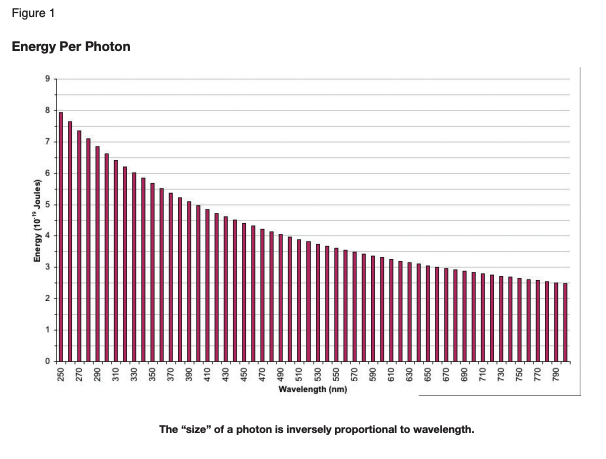
To determine a material’s photodegradation risk factor, one can compare its unique spectral sensi - tivity to the SPD of the light source(s) that it could encounter during its expected service life. For example, Figure 4 shows a graph of the SPD of sunlight superimposed on a graph of the spectral sensitivity of polypropylene and polyethylene. The region underneath where the two graphs overlap is the region of risk. The larger the area of risk, the greater the expected degradation.
Lux
Indoor lighting is normally measured in lux. Lux is based on the Photopic Response Curve. This is a standardized measure of the human eye’s response to light, defined as a unit of illuminance equal to one lumen per square meter (equivalent to .093 footcandles).
Because lux is based on the human eye’s response to light, it is very useful for comparing relative light levels and relative efficiency of vari - ous light sources. Lux is useful only for purposes of human vision, not for photodegradation.
Researchers use lux to quantify, monitor and con - trol indoor lighting. This works well for illumination comparisons. Unfortunately, some researchers inappropriately use lux to try to quantify the qual - ity of light when studying material durability. This misuse is due to a misunderstanding of the nature of lux itself.
The Photopic Response Curve, upon which lux is based, is a bell-shaped curve that is centered at 555 nm and extends from approximately 400 nm to 700 nm. While a useful measure of the light ef - ficiency for illumination, it is worse than useless for material science. “Worse than useless” because it is misleading. In other words, there is no relation - ship between the spectral sensitivity of any mate - rial and the eye’s response to light. In fact, in the long wave UV, exactly the region where the eye’s response is dropping to zero, we find the spec - tral response of most materials climbing rapidly. While using a luxmeter to determine illumination levels for taking photographs, reading or viewing artworkis extremely useful, it should not be used for quantifying the photodegradation risk factor of a lighting environment. It should not be used to generate “reciprocity formulas.”
Unfortunately, several photography test standards specify the use of lux as a means to time radiant dosage. A more appropriate measurement would be to use radiant energy measured in an appropri - ate spectral region, typically in watts per square meter (W/m 2).


Survey of Manufactured Light Sources Used Indoors
Indoor lighting comes in a large number of options. Market pressure for cost savings and conservation has resulted in a constant stream of new refinements: brighter, longer lived, more efficient, smaller, etc. This section will examine a number of the most common types of lighting that a material would be expected to encounter indoors.
For the purposes of this paper, the term artificial light sources (i.e., lamps) refers to the process of how light is created. Artificial light can be categorized as either incandescent filament or electric discharge.
According to a recent Kodak study (Bugner et al), residential home lighting intensities are 120 lux per 12 hour day. Typical commercial intensities would be much higher. Henry Wilhelm has published a benchmark of 420 lux per 12 hour day for commercial lighting. Measurements in our own offices indicate that 500 lux might be a more realistic benchmark. Therefore, for purposes of comparison, all of the following graphs show the manufactured light source at 500 lux.
Incandescent Filament Lamps consist of a glass bulb containing a wire filament (usually tungsten) that radiates light when heated. Filaments of standard incandescent lamps are enclosed in a vacuum or in a gas-filled bulb. Much of the energy is lost as heat; therefore, standard incandescent lamps are very energy inefficient. Incandescent lamps are the typical “light bulbs” (such as soft whites) used for residential home lighting and tungsten halogen lamps. Following is a Spectral Power Distribution (SPD) graph of three incandescent lamp types.
Halogen Lamps are a type of incandescent lamp with an outer jacket made of borosilicate glass and a tungsten halogen capsule that is made from quartz and contains a filament, lead wires and a halogen gas mixture. The halogen gases allow the filaments to operate at higher temperatures and higher efficiencies than other incandescent lamps. Halogens provide brighter, whiter light with better color characteristics, longer life and improved energy efficiency.
Electric Discharge Lamps create light from an electric discharge between two electrodes in a glass tube, like a lightning bolt. However the arc is continuous. As the current is passed through a low pressure gas, the electrons collide with the gas atoms, releasing photons of radiation. Electric discharge lamps include: mercury vapor lamps, metal halide lamps and high pressure sodium lamps. These are all known as High Intensity Discharge or HID lamps. Another type of electric discharge lamp is the fluorescent lamp.
Mercury Vapor Lamps contain two operating eletrodes and a starting electrode. The light produced is in the characteristic mercury emission lines (404 nm, 435 nm, 546 nm and 577 nm) plus a small amount of UV energy. A clear mercury vapor lamp produces a blue-green colored visible light. Mercury vapor lamps are used for retail store lighting, street lighting, industrial high-bay, and parking lot lighting.
Metal Halide Lamps are a type of electric discharge lamp that provide long life and good color rendering properties. They are the most common lamp type for factory lighting, industrial warehouses and retail stores. The lamp type is called “metal halide” because a compound of a metal and iodine is called a “metal halide” salt.
Sodium Lamps are electric discharge lamps. Sodium and mercury vaporize within the lamp, producing visible light. Sodium lamps are strongest in the yellow and orange range of the spectrum and weakest in blue-green wavelengths. Mercury is sometimes added to strengthen blues and greens. Sodium Lamps have the highest efficacy of all lamps currently available.
- Low Pressure Sodium Lamps emit a single frequency of light, a monochromatic yellow at 589 nm. They are best suited for outside areas such as parking lots or street lighting, because the monochromatic light is conductive to viewing in detail.
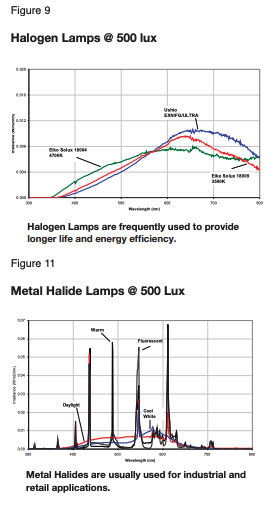
High Pressure Sodium Lamps provide warmer yellow-orange color and are used for both street lighting and industry interiors like factory lighting and warehouses. They are the most efficient HID lamps available today
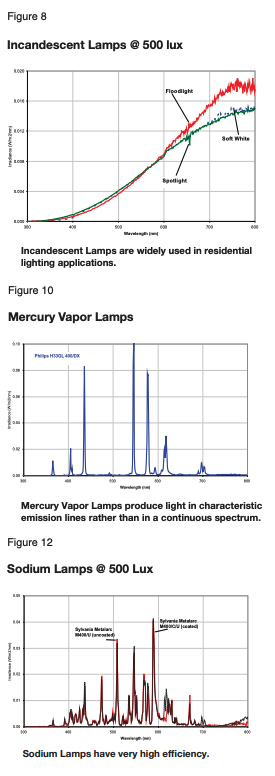
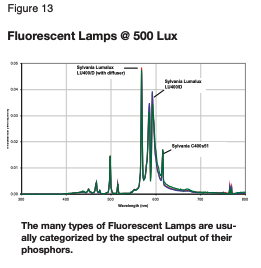
Fluorescent Lamps are a type of mercury vapor lamp used for commercial retail lighting and office environments. They are more efficient than incan - descent lamps and radiate less heat. Fluorescent lamps typically consist of a long, narrow glass tube whose inside surface is painted with a fluorescent phosphor. The tube also contains an inert gas and a small amount of mercury. When electricity is passed through the lamp, the mercury vapor is ex - cited and emits UV radiation. The UV is absorbed by a phosphor coating on the inside of the glass tube. The phosphor then re-emits visible light. The many types of fluorescent lamps are usually categorized by the light output of their phosphors.
Cool White Fluorescent Lamps are the most widely used fluorescent lamp and are popular for their economy. They are used in areas where color rendering is not critical.
Warm White Fluorescent Lamps improves color in offices, stores by emitting a “warmer” light than cool white.
Daylight Fluorescent Lamps are designed to simu - late the color of daylight and are used in locations where color rendering is important (e.g., jewelry stores, color matching booths, museums, hospi - tals, etc.).
Compact Fluorescent Lamps are designed to re - place screw-in incandescent bulbs combining the efficiency of fluorescent lighting with the conve - nience of standard incandescent bulbs. They are primarily used for residential home lighting, hotel and restaurant lighting. Like traditional fluores - cents, compact lamps come with a variety of phosphors to function in a range of applications.
Natural Light Sources
Natural light sources include direct sunlight and indirect (diffuse) sunlight. The CIE (Interna - tional Commission on Illumination) defines direct sunlight in publication 85, table 4 (1989). This is equivalent to noon, summer sunlight in the North - ern Hemisphere. This is also known as Air Mass 1. Numerous ISO and ASTM committees have incorporated this sunlight benchmark in their test methods and specifications.
The spectrum and intensity of sunlight vary throughout the day. When the sun is lower in the sky, there is more filtering from the earth’s atmosphere. An extreme example of this occurs at sunset, when most wavelengths except for the long wave visible are filtered, and the sunlight appears red. Figure 14 shows the spectral power distribution of direct sunlight measured at various times throughout the day.
"North Sky" sunlight (diffuse sunlight) is of course much less intense overall than direct sunlight. But counter-intuitively, the proportions of UV wave - lengths in diffuse north sky sunlight are virtually identical to the proportions in direct sunlight. They have the same “relative SPD” because of UV scattering. Figure 15 shows the spectral power distribution of benchmark CIE Sunlight compared to North Sky Sunlight. Figure 16 illustrates that the relative proportions of North Sky and Direct Sunlight are virtual identical due to UV scattering (normalized at 420 nm).
Window-filtered Sunlight . The shortest of the UV wavelengths are filtered out by window glass and the solar cut off shifts from approximately 295 nm to about 310 nm. Glass that is dirty, thicker, tinted, laminated, or double-pane would have even less UV transmission. The figure below compares direct sunlight (Air Mass 1), and sunlight filtered through window glass.
In a recent study conducted by Kodak (Bugner et al), long-term light levels and spectral energy dis - tributions were measured in 32 homes in 4 cities (Rochester, London, Los Angeles & Melbourne). Figure 18 plots the average in-home SPDs in these cities.
The Kodak study concluded, “From the shape of the spectra, it is evident that indoor display lighting... is dominated by indirect window-fil - tered daylight. Only 8% of the total irradiance is in the UV region (300-400 nm), with 26% in the blue (400-500 nm), 31% in the green (500-600 nm), and 35% in the red (600-700 nm). Note the relatively low energy levels in the UV region. This is likely due to the combination of glass filtration and partial absorption of light reflected off interior surfaces.”

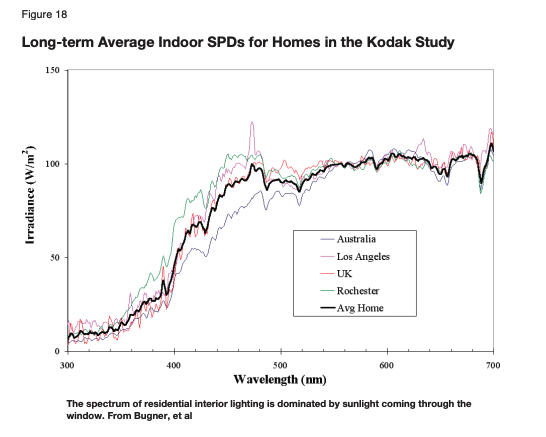
Sunlight & Man-Made Light Sources Compared
A comparison of the spectrum of window-filtered sunlight and the various man-made indoor light sources illustrates that sunlight through glass encompasses the spectral emissions of all the common manufactured indoor light sources (Figure 19). In other words, window-filtered sunlight typically produces more of the highly damaging, short wave UV than man-made light sources. Therefore, it is the most severe spectrum that an indoor product is likely to encounter.
A comparison of light intensity shows that direct sunlight which comes through the window is approximately 200x brighter than the normal lighting level for a well lit room. Indirect (or North Sky) sunlight has only about 70% of the intensity of direct sunlight, and a very similar spectrum. This is still about 150x more intense than a typical well lit room. Figure 20 shows the relative intensities of natural sunlight through glass compared to the man made light sources at 500 lux. This is the same data as shown in Figure 19, except with a change in scale to show the normal full intensity of sunlight. As illustrated, the manufactured light source intensity is trivial by comparison.
Therefore, on the basis of both spectrum and wavelength, it can be said that window-filtered sunlight is the most severe lighting condition that most products can be expected to encounter during their service life indoors.
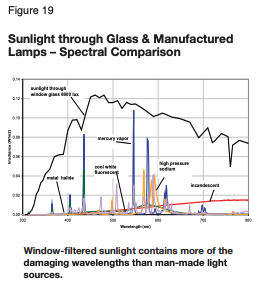
Laboratory Simulations
Laboratory test chambers with xenon arc lamps Lamps – Intensity Comparison are frequently used for testing the light stability of materials.
A xenon arc lamp consists of a glass tube filled with xenon gas, in which an electric discharge is created between two electrodes. Because the xenon lamp produces an excess of very short wavelength UV, it is necessary to use special optical glass filters to modify the UV and produce the desired spectrum. There are many types of filters for xenon lamps and it is important to use the proper filter.
A xenon arc, when properly filtered, provides a surprisingly good simulation of window filtered sunlight. As shown in Figure 21, the xenon arc reproduces all of the damaging wavelengths, including UV, visible light and infrared light. Consequently, several industries have standardized on the xenon arc to test products for indoor light stability. A partial list is provided in Table A.
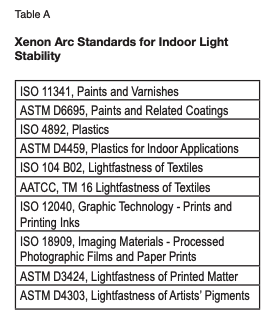
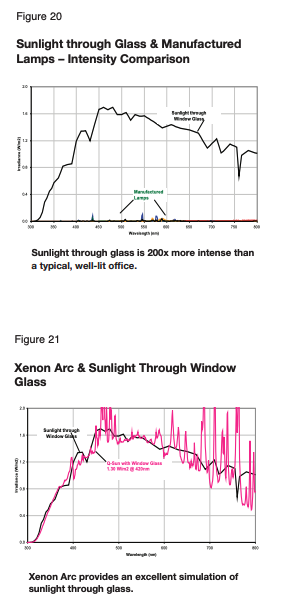
Conclusions & Recommendations
- In residential, retail, and manufacturing environments products may be exposed indoors to a myriad of natural and artificial light sources.
- There is not a single representative indoor light spectrum that addresses all of these environments. However, because the most severe indoor lighting environment is sunlight filtered through window glass, it is reasonable that the best laboratory simulation would mimic this spectrum and intensity.
- A xenon arc with a Window Glass Filter produces an excellent simulation of direct sunlight through glass.
- Filtered xenon is the preferred method for testing indoor light stability.
Appendix on Reciprocity
The Law of Reciprocity is often used to predict service life of materials exposed to light. For example, museum conservators commonly use it to estimate the amount of light that they can use in their displays while minimizing photodegradation. Reciprocity assumes that a limited exposure to high-intensity light will have the same effect as a long exposure to low-intensity light. This is sometimes true, as far as it goes. Unfortunately, it really doesn’t go very far. There are several reasons for this.
- Every material has its own unique spectral sensitivity.
- Temperature will accelerate the rate of a chemical reaction. While most photochemical reactions are not temperature sensitive, the typical subsequent secondary reactions are driven by temperature.
- Many photo-initiated reactions will continue in the absence of light.
- Humidity can cause a number of reactions (e.g., dye migration).
- Ozone and other gases can cause fading of inks and dyes.
- Some degradation reactions are non-linear. A classic example of this is when a UV absorber protects a material, but eventually is “used up” resulting in a sudden degradation “crash.”
- Historically, most of the measurements of light used for reciprocity calculations have been taken using a luxmeter and consequently measure a portion of the spectrum which is relatively harmless to most photosensitive materials. Further, these measurements are often used to compare light sources with significantly different spectra. Discrepancies between sources with a high UV content versus a low UV content are not apparent from luxmeter measurements. However the relative photodegradation risk factor would be significantly different.
Consequently, reciprocity will only work on some materials and then only if there are no variations in spectrum, temperature, and humidity.
Acknowledgements
SPD curves of sunlight and manufactured light sources were measured by Gregory Fedor and William Solarz at Q-Lab’s central research lab.